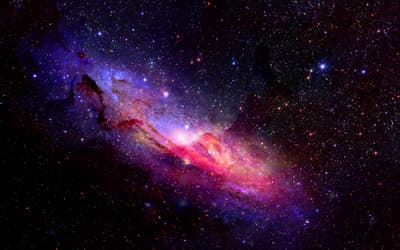
A Deeper Discussion of the Factors That Affect the Earth’s Rotation and Clarifying Its Role in the Tidal Evolution of the Earth-Moon System
Dr. Danny R. Faulkner • Sept. 17, 2025
There are far more factors than tidal braking involved in the earth’s changing rotation period. In this paper, I show that the picture is far more complicated than many recent creationists realize.

Sizes of Galaxies in JWST Data and Cosmology—Reply to Barnes
Dr. Jason Lisle • Aug. 20, 2025
The Doppler model is currently the only cosmological model that is consistent with both angular size and luminosity data from JWST observations, and it alone passes the Tolman test.

Size of Galaxies in JWST Data and Cosmology— Reply to Lisle
Luke A. Barnes • Dec. 18, 2024
Luke Barnes critiques Jason Lisle’s “Doppler Model” of 2024.

A Refutation of Lisle’s “Refutation” of Dennis (2024)
Dr. Phillip W. Dennis • Nov. 20, 2024
Dr. Dennis responds to Dr. Lisle’s arguments on the speed of light, suggesting a different interpretation of relativity.

Sizes of Galaxies in JWST Data Suggest New Cosmology
Dr. Jason Lisle • July 24, 2024
New data is consistent with biblical creation, not the big bang.

An Internal Contradiction of Lisle’s Anisotropic Synchrony Convention (ASC) Model
Dr. Phillip W. Dennis • July 10, 2024
Dr. Dennis discusses Dr. Lisle’s anisotropic synchrony convention in regards to the light travel time problem.

Thermodynamics and its Relation to Creation/Evolution: An Introduction
Dr. Danny R. Faulkner • March 6, 2024
Creationists have often used the 2nd law of thermodynamics to criticize naturalistic origins, but they have not always properly treated the subject.

Bible-Based Knowledge (Science)
Richard Overman • Jan. 17, 2024
This paper proposes biblically based scientific philosophies as well as providing suggested mechanisms for the development of a bible-based scientific model for the four major scientific communities.

The Philosophy of Science 4: A Brief History of Science from the Scientific Revolution to Modern Physics
Dr. Danny R. Faulkner • June 21, 2023
This paper traces the history of science from 1687 to today. It mentions the philosophies of deism and determinism and discusses modern-day quantum mechanics and chaos theory.

Mach’s Principle in General Relativity and Reduced Light Travel Times in Cavitated Cosmologies
Dr. Phillip W. Dennis • Oct. 26, 2022
We explore the effect of cosmic voids on the light-travel-time-problem (LTTP) in a young age creationist (YAC) cosmology.

The Role of the Burbidges in Opposing the Acceptance of Dark Matter: A Cautionary Tale
Dr. Danny R. Faulkner • Feb. 3, 2021
Geoffrey and Margaret Burbidge played a key role in slowing the acceptance of dark matter. Therein lies a cautionary tale for scientists.

Inerrancy and Biblical Authority: How and Why Old-Earth Inerrantists Are Unintentionally Undermining Inerrancy
Dr. Terry Mortenson • Sept. 16, 2020
The old-earth signers of the CSBInerrancy unintentionally violated their own principles of interpretation and unintentionally undermined the inerrancy and the authority of Scripture.

An Evaluation of Astronomical Young-Age Determination Methods 2: Solar, Stellar, Galactic, and Extragalactic
Dr. Danny R. Faulkner • Oct. 30, 2019
Dr. Danny Faulkner evaluates 23 arguments for recent origin for the sun, stars, and galaxies.

An Evaluation of Astronomical Young-Age Determination Methods I: The Solar System
Dr. Danny R. Faulkner • Sept. 25, 2019
Evaluating 25 astronomical arguments for recent origin for the solar system found some to be wanting and others appear to be sound.

Abortion: A Biblical, Biological, and Philosophical Refutation
Matt Dawson • Jan. 23, 2019
A holistic approach which accounts for biblical, biological, and philosophical truths must conclude that the unborn represent human beings with full personhood.

The Case for Dark Matter
Dr. Danny R. Faulkner • March 22, 2017
We ought not to dismiss the observational science for dark matter over fears of the misuse of dark matter in historical science.

Determination of the Radioisotope Decay Constants and Half-lives: Potassium-40 (40K)
Dr. Andrew A. Snelling • Aug. 3, 2016
Dr. Snelling documents the methodology and history of determining present decay constants and half-lives of parent radioisotopes used for dating methods.

New Method to Assess the Luminosity Function of Galaxies
Dr. Jason Lisle • March 30, 2016
We find that small variations in galaxy density as a function of redshift do exist, and are not due to the Malmquist bias.

Thoughts on the rāqîa‘ and a Possible Explanation for the Cosmic Microwave Background
Dr. Danny R. Faulkner • March 23, 2016
Dr. Danny Faulkner proposes that Genesis 1:1 is an introductory encapsulation that establishes a foundation for building a biblical model of astronomy.

Revisiting an Iconic Argument for Milankovitch Climate Forcing: Should the “Pacemaker of the Ice Ages” Paper Be Retracted? Part 1
Dr. Jake Hebert • March 9, 2016
This paper, the first in a series, demonstrates that much of the Hays et al. paper, as originally presented, is invalid.

Radioisotope Dating of Meteorites: V. Isochron Ages of Groups of Meteorites
Dr. Andrew A. Snelling • Dec. 16, 2015
This contribution is designed to document the radioisotope dating data for groups of chondrites, stony achondrites, pallasites and mesosiderites, and irons.

Determination of the Radioisotope Decay Constants and Half-Lives: Samarium-147 (147Sm)
Dr. Andrew A. Snelling • June 10, 2015
Over the last 80 years numerous determinations have been made of the 147Sm half-life.

Radioisotope Dating of Meteorites: IV. The Primitive and Other Achondrites
Dr. Andrew A. Snelling • May 6, 2015
This paper documents radioisotope dating for meteorites, achondrites, angrites, aubrites, mesosiderites, and irons to further discuss significance of the data.

The Blurring Distinction between Asteroids and Comets
Dr. Danny R. Faulkner • April 29, 2015
Whether there is a continuum on which our older conception of asteroids and comets are extremes or if there still is a gap between them is not entirely clear.

Can One Astronomically Date the Flood within the Hydroplate Model?
Dr. Danny R. Faulkner • April 1, 2015
Dr. Danny Faulkner analyzes Dr. Walt Brown’s determination of the date of the Flood within his hydroplate model using the orbits of two comets.

Speculation on Redshift in a Created Universe1
Dr. John G. Hartnett • Feb. 11, 2015
Dr. Hartnett speculates about the idea that what we observe in the universe is not in equilibrium; that is, the state of the universe is in a transient state.

A Biblical Creationist Cosmogony
Dr. John G. Hartnett • Jan. 14, 2015
The cosmogony proposed is consistent with all creationist understandings of the biblical texts and has no light-travel time problem.

Determination of the Radioisotope Decay Constants and Half-Lives: Lutetium-176 (176Lu)
Dr. Andrew A. Snelling • Dec. 3, 2014
If the Lu-Hf dating method has been calibrated against the U-Pb “gold standard” with its own uncertainties, then it cannot be absolute.

Discerning Tyrants from Usurpers: A Statistical Baraminological Analysis of Tyrannosauroidea Yielding the First Dinosaur Holobaramin
M. Aaron • Nov. 26, 2014
In this study, I analyzed a theropod dinosaur group, Tyrannosauroidea, through the use of statistical baraminology.

Response to: “Critique: Faulkner’s Miraculous Translation of Light Model Would Leave Evidence”
Dr. Danny R. Faulkner • Nov. 19, 2014
I am delighted that my friend, John Hartnett, has responded with some objections to my proposal for a new solution to the light travel time problem.

Critique: Faulkner’s Miraculous Translation of Light Model Would Leave Evidence
Dr. John G. Hartnett • Nov. 19, 2014
In 2013 D. R. Faulkner proposed what he says is a new solution to the biblical creationist starlight travel-time problem.

Expansion of Space—A Dark Science
Dr. John G. Hartnett • Nov. 13, 2014
I contend that expansion of space is of itself not tenable as a mechanism for the expansion of the universe.

A Missing Neutrino—Dark Radiation
Dr. John G. Hartnett • Sept. 24, 2014
From various problems in cosmology a need has developed to postulate the existence of unknown types of energy and matter from the dark side.

Determination of the Radioisotope Decay Constants and Half-Lives: Rubidium-87 (87Rb)
Dr. Andrew A. Snelling • Sept. 3, 2014
In spite of numerous attempts for over 60 years to determine the 87Rb half-life and decay constant, there is still no consensus.

Circular Reasoning in the Dating of Deep Seafloor Sediments and Ice Cores: The Orbital Tuning Method
Dr. Jake Hebert • Aug. 27, 2014
The different dating systems are calibrated to one another: dates assigned to the seafloor sediments are used to date the ice cores, and vice versa.

A Photon Reference Frame and Distant Starlight: Analyzing Ideas from Gerald L. Schroeder’s The Science of God
Andrew Sibley • May 14, 2014
This paper reviews claims made by Gerald L. Schroeder in relation to the nature of light and the age of the universe.

A Discussion of Stellar Nucleosynthesis
Dr. Danny R. Faulkner • April 30, 2014
Astronomers have developed an elaborate, physically robust evolutionary theory to explain the abundances that we see throughout the universe. While this theory may be explanatory, it has no predictive

Radioisotope Dating of Meteorites: I. The Allende CV3 Carbonaceous Chondrite
Dr. Andrew A. Snelling • April 16, 2014
Meteorites have been used to date the earth with a 4.55 ± 0.07 Ga Pb-Pb isochron called the geochron.

Radiohalos in Multiple, Sequentially Intruded Phases of the Bathurst Batholith, NSW, Australia: Evidence for Rapid Granite Formation during the Flood
Dr. Andrew A. Snelling • March 5, 2014
There is evidence for rapid granite formation during the Flood.

The Second Law of Thermodynamics and the Curse
Dr. Danny R. Faulkner • Nov. 13, 2013
Many recent creationists believe that the second law of thermodynamics came into being as a result of the Fall or the curse. I argue that this is not supported by Scripture nor science.

An Evaluation of Plasma Astronomy
Dr. Danny R. Faulkner • Sept. 4, 2013
Dr. Faulkner examines the claims of one proponent of plasma astronomy, Donald Scott.

A Proposal for a New Solution to the Light Travel Time Problem
Dr. Danny R. Faulkner • Feb. 23, 2014
Danny R. Faulkner, AiG–U.S., lays groundwork for the beginning of a new solution to the light travel time problem.

Astronomical Distance Determination Methods and the Light Travel Time Problem
Dr. Danny R. Faulkner • June 12, 2013
Some recent creationists have attempted to address the light travel time problem indirectly with an implied appeal to a small universe.

An Analysis of the Dodwell Hypothesis
Dr. Danny R. Faulkner • May 15, 2013
Danny R. Faulkner, AiG–U.S., examines the Dodwell hypothesis, that the earth underwent a catastrophic impact in 2345 BC that altered its axial tilt and then gradually recovered by about 1850.

Untangling Uniformitarianism, Level II: Actualism in Crisis
Dr. John K. Reed • Nov. 30, 2011
Although the term uniformitarianism was not introduced until 1832, the concepts that Lyell so cleverly fused together had already been operating in the nascent discipline of geology for some decades

Beyond Distant Starlight: Next Steps For Creationist Cosmology
James Upton • Jan. 26, 2011
On both large and small cosmic scales there is a diverse range of trends, patterns, and phenomena that beckon some kind of explanation.

Anisotropic Synchrony Convention—A Solution to the Distant Starlight Problem
Dr. Jason Lisle • Sept. 22, 2010
Clear biblical teaching is that the universe is only a few thousand years old, so we should only be able to see objects within a radius of 6,000 light years.

Untangling Uniformitarianism
Dr. John K. Reed • March 17, 2010
Of the nine terms associated with uniformitarianism, seven can be replaced or eliminated, which refutes the accusation that diluvialists do not understand uniformitarianism.

Numerical Simulation of Precipitation in Yosemite National Park with a Warm Ocean: A Pineapple Express Case Study
Wesley Brewer , et. al. • Feb. 17, 2010
Based on the likely increase in precipitation rate and frequency of storms following the Genesis Flood, glaciers thousands of feet thick would have developed in a few hundred years.

A Brief History of Intolerance in Modern Cosmology
Dr. Jerry Bergman • Jan. 21, 2009
A review of some recent well-documented cases of intolerance in the cosmology field illustrates a common problem in science. Many relate to the Big Bang theory.

An Apology and Unification Theory for the Reconciliation of Physical Matter and Metaphysical Cognizance
Desmond Allen • Feb. 27, 2008
Because one is tangible and the other intangible, the physical and metaphysical are generally treated separately. But this dichotomy is illogical.
